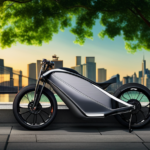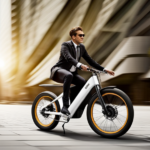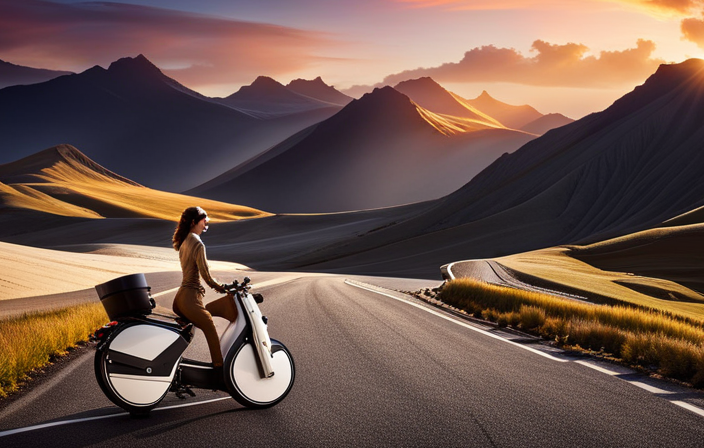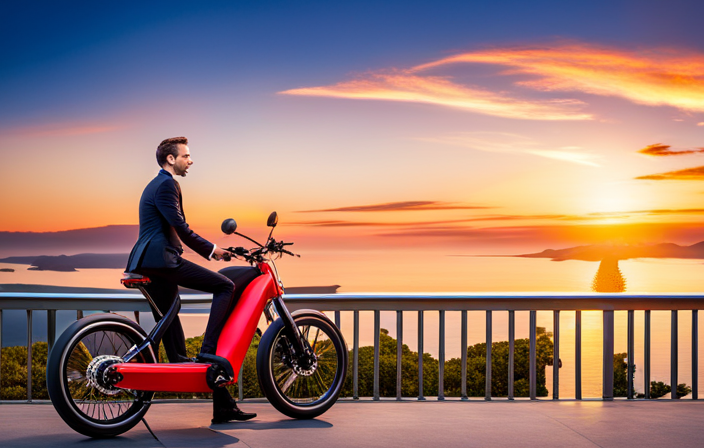Have you been aware that testing your electric bike charger is essential in order to guarantee its effectiveness and safety?
With the increasing popularity of electric bikes, it’s important to know how to properly test your charger.
In this article, we will guide you through the process of testing your electric bike charger step by step.
By following these instructions, you can ensure that your charger is functioning correctly and avoid any potential issues during charging.
Key Takeaways
- Test the charger with different outlets and power sources to ensure proper connection and compatibility.
- Use a multimeter and clamp meter to check voltage output and current flow, respectively, and test the charger with a known working battery.
- Look for visual signs of damage or overheating, as well as any unusual sounds or smells coming from the charger.
- If unsure or uncomfortable with DIY troubleshooting, seek professional assistance to prevent further damage and ensure safety.
Understand the Basics of Electric Bike Chargers
You should understand the basics of electric bike chargers before testing yours. It is crucial to consider the charging compatibility with different bike models. Not all chargers are compatible with every bike, so it’s essential to ensure that your charger is suitable for your specific electric bike.
Additionally, understanding the charging capacity and limitations of electric bike chargers is important. Each charger has a maximum output power, and exceeding this limit can damage your battery or even pose a safety risk. Familiarize yourself with the charging specifications provided by the manufacturer to avoid any potential issues.
Now that you have a good grasp of electric bike charger basics, let’s move on to checking the power source.
Check the Power Source
To check the power source, start by verifying its functionality. Check the voltage output to ensure it meets the required specifications for your electric bike charger. You can use a multimeter to measure the voltage. If the power source is not providing the correct voltage, it may be faulty and should be replaced.
Next, test the charger with a different device to see if it functions properly. Connect the charger to another compatible device and observe if it charges the device as expected. This will help determine if the charger itself is working correctly.
Once you have checked the power source and tested the charger’s functionality, you can move on to inspecting the charger’s physical condition.
Inspect the Charger’s Physical Condition
Take a close look at the physical condition of your charger. Inspect the charger’s cable and check for any loose connections. Start by examining the cable for any signs of fraying, cuts, or other damage. Ensure that the cable is securely connected to both the charger and the power source. Look for any loose or bent pins in the charging port.
Inspect the charger itself for any visible damage or wear. Check if the LED indicator lights are functioning properly. A damaged or faulty charger can affect the charging process and potentially damage your electric bike’s battery.
After inspecting the physical condition of the charger, you can move on to testing the charger with a multimeter to ensure its electrical functionality.
Test the Charger with a Multimeter
Start by using a multimeter to check the electrical functionality of the charger. This simple tool will allow you to test the charger’s voltage output, ensuring it is providing the correct amount of power to your electric bike.
Here are three important steps to follow when using a multimeter to test your electric bike charger:
- Set the multimeter to the voltage measurement mode.
- Connect the multimeter probes to the charger’s positive and negative terminals.
- Read the voltage displayed on the multimeter. It should match the charger’s specified output voltage.
Additionally, it’s crucial to check the charger’s compatibility with different electric bike models. Make sure the charger you are testing is suitable for your specific bike to avoid any potential issues.
Once you have confirmed the charger’s voltage output, you can proceed to the next section and check the charging indicator.
Check the Charging Indicator
Check if the charging indicator on your electric bike charger is illuminated when it is plugged in. This indicator is designed to show whether the charger is functioning properly or not. If the charging indicator does not light up, it could indicate a problem with the charger.
Before proceeding with further testing, it is important to visually inspect the charger for any damages such as frayed wires or bent prongs. If you notice any physical damage, do not attempt to test the charger yourself. Instead, it is recommended to consult a professional for assistance.
Once you have checked for damages and ensured the charger is in good condition, you can move on to the next step of testing the charger with a compatible battery.
Test the Charger with a Compatible Battery
To continue testing your electric bike charger, the next step is to test it with a compatible battery. This will help ensure that the charger is functioning properly and can deliver the necessary power to charge your bike.
First, check the charger’s compatibility with different bike models to ensure it can support your specific electric bike. Connect the charger to the battery and observe if it starts charging. Pay attention to any signs of malfunction, such as overheating or inconsistent charging.
Additionally, test the charger’s durability and resistance to common wear and tear by using it multiple times with different batteries. This will help determine if the charger can withstand regular usage without any issues.
Once you have completed this test, you can move on to verifying the charging time in the next section.
Verify the Charging Time
Make sure you observe and record the charging time of your battery to verify if it meets the expected time for a full charge. To do this, follow these steps:
-
Measure the voltage output: Use a multimeter to measure the voltage output of your electric bike charger. Make sure it matches the voltage specified by the manufacturer.
-
Compare charging times with different electric bike chargers: If you have access to multiple electric bike chargers, test each one and compare their charging times. This will help you determine if your charger is working efficiently or if it is taking longer than it should.
-
Record the charging times: Keep a record of the charging times for each charger you test. This will provide valuable data for future reference and troubleshooting.
Once you have measured the voltage output and compared the charging times, consult the manufacturer’s instructions or customer support for further guidance.
Consult the Manufacturer’s Instructions or Customer Support
Consult the manufacturer’s instructions or contact customer support for further guidance.
When testing your electric bike charger, it is essential to troubleshoot common charging issues and understand charging safety precautions. The manufacturer’s instructions will provide specific guidelines on how to test the charger properly and ensure its functionality. They may outline steps such as checking the LED indicators, inspecting the charging cable for any damages, and verifying the correct voltage output.
Additionally, contacting customer support can provide valuable assistance in troubleshooting any specific issues you may encounter during the testing process.
Once you have consulted the manufacturer’s instructions or reached out to customer support, you can consider using a different outlet or power source if necessary. This will help you determine if the issue lies with the charger or the power supply.
Consider Using a Different Outlet or Power Source
Consider trying a different outlet or power source to determine if the issue lies with the charger or the power supply.
Different charging methods can affect the performance of your electric bike charger. It is important to troubleshoot common charger issues to ensure optimal charging efficiency.
Start by plugging the charger into a different outlet or using a different power source. This will help identify if the problem is with the charger itself or the power supply.
If the charger works fine with a different outlet or power source, then the issue might be with the original power supply. On the other hand, if the charger still fails to function properly, then it is likely a problem with the charger.
Seek professional assistance if necessary to further diagnose and resolve the issue.
Seek Professional Assistance if Necessary
If you’ve tried different outlets or power sources for your electric bike charger and it still isn’t working, it may be time to seek professional assistance.
When dealing with electrical components, it’s important to prioritize safety and ensure that the issue is properly diagnosed and resolved.
Professional technicians have the knowledge and expertise to troubleshoot common charger issues and identify any underlying problems.
They can also provide guidance on how to test your electric bike charger effectively.
Seeking professional help can save you time and frustration, as well as prevent further damage to your charger or bike.
Remember, it’s always better to be safe than sorry when it comes to electrical equipment.
Frequently Asked Questions
Can I use any charger for my electric bike or do I need a specific one?
To ensure optimal charging speed and avoid common charging issues, it is important to use a specific charger designed for your electric bike. Using any charger may result in compatibility issues and potentially damage the battery.
How often should I test my electric bike charger?
Properly maintaining and cleaning your electric bike charger is key to its longevity. Look out for common signs of a faulty charger, such as overheating or slow charging. Regularly testing your charger ensures optimal performance.
What should I do if the charging indicator on my electric bike charger is not working?
To troubleshoot a non-working charging indicator on your electric bike charger, first check the power supply and ensure it is functioning properly. Then, use a multimeter to test the charger’s voltage output and identify any potential issues.
Is it safe to charge my electric bike battery overnight?
To optimize the lifespan of your electric bike battery and minimize potential risks, avoid charging it overnight. Instead, aim for shorter charging periods and unplug once fully charged. This will help maintain battery health and prevent overcharging.
How can I determine if my electric bike charger is compatible with my battery?
To determine compatibility between your electric bike charger and battery, check the voltage and current ratings of both. Ensure that the charger’s output matches your battery’s requirements. Testing efficiency can be done by monitoring charging time and observing any abnormal behaviors during the charging process.
Conclusion
In conclusion, testing your electric bike charger is crucial to ensure its functionality and your safety. By following the steps outlined in this article, you can effectively test your charger and identify any potential issues.
It’s interesting to note that, according to a recent survey, a faulty charger is one of the leading causes of electric bike accidents. This statistic highlights the importance of regularly testing your charger to prevent any mishaps and maintain a safe riding experience.
















